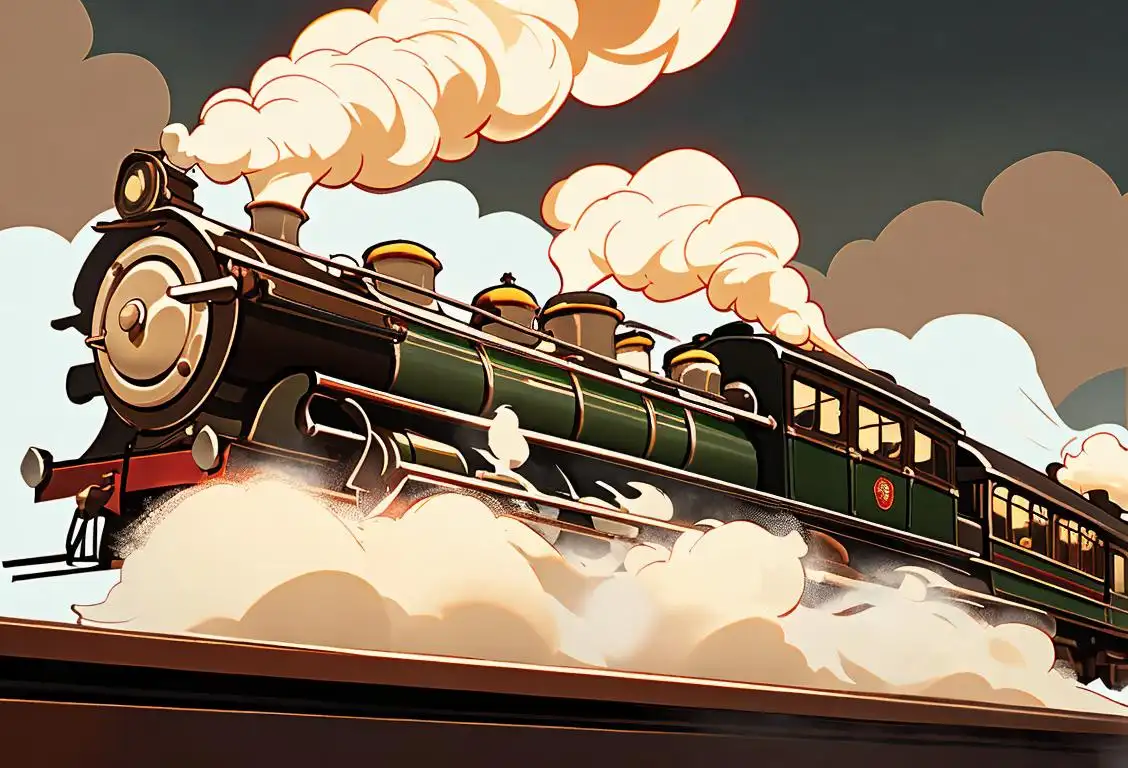National Steam Day

Welcome to the wonderful world of steam, where hot water meets incredible power! Today we celebrate National Steam Day, a day to appreciate the many uses and wonders of steam. From trains chugging along the tracks to indulging in a steamy bowl of soup, let's dive into the fascinating history and joyous celebrations of this special day.
When is Steam Day?
It's national steam day on the 8th November.
The Power of Steam
Steam, my friend, is like the magical genie living inside a tea kettle. Once heated, it escapes with incredible force, ready to create wonders and adventure in its wake. The true potential of steam was realized during the Industrial Revolution, where it powered mighty steam engines and transformed the world of transportation.
Steam locomotives revolutionized travel, allowing people to traverse vast distances at unheard-of speeds. The sound of a steam engine's whistle echoed through the countryside, as excited passengers boarded the train, eager to see what lay ahead. Oh, the nostalgia!
But steam didn't stop at trains. It became the beating heart of factories, bringing life to gigantic spinning machines and propelling the wheels of industry. From weaving fabrics to shaping metals, steam was the powerhouse that drove progress and ignited the flame of innovation.
Steam in Everyday Life
While steam engines and factories are impressive, let's not forget the marvelous ways steam enhances our daily lives. Ever enjoyed a relaxing steam bath or sauna? Ah, the warmth and purifying power of steam enveloping your body, melting away stress and tension. It's like a soothing hug from a cloud!
And how about our kitchens? Steaming vegetables not only retains their nutrients but also brings out their vibrant colors and flavors. Dim sum lovers rejoice, for those dumplings are steamed to perfection, creating little pockets of deliciousness just waiting to be devoured.
In the world of science, steam has been harnessed to generate electricity and clean up the environment. Steam turbines spin faster than children chasing an ice cream truck, transforming the energy of hot steam into electrical power. It's an eco-friendly and exhilarating way to light up our lives!
Celebrating National Steam Day
On National Steam Day, there are countless ways to embrace the power of steam. Pay a visit to a steam museum and immerse yourself in the rich history of steam engines. Marvel at the massive machinery that once propelled the world forward, and perhaps even huff and puff like the Little Engine That Could.
If you're feeling crafty, why not try your hand at building a miniature steam engine? Delve into the intricate world of gears, valves, and pistons, and watch as your creation comes to life, emitting wisps of steam that reveal your engineering prowess.
For the culinary enthusiasts, it's the perfect day to whip up a steamy feast. Steam some delectable seafood or veggies, and bask in the joy of healthy, flavorful cooking. And don't forget to raise a toast to the humble kettle, the unsung hero that heats our water for tea and coffee. Hooray for the little things!
History behind the term 'Steam'
1st century BC
Ancient Greek Theories
In the 1st century BC, the term 'steam' made its debut through ancient Greek theories. Philosophers such as Hero of Alexandria pondered the nature of steam and its ability to exert force. They recognized that heated water transformed into a vapor, which possessed energy and could be utilized as a source of power.
1698
First Steam Pump
The year 1698 marks an important milestone in the history of steam. Thomas Savery, an English inventor, developed the first practical steam pump known as the 'Miner's Friend.' This device used steam pressure to draw water out of mines, making it easier and safer for miners to work. It was a significant application of steam power.
1765
Watt's Steam Engine
James Watt, a Scottish engineer, revolutionized the use of steam in 1765 when he patented the steam engine. His design greatly improved the efficiency of steam engines by introducing a separate condenser, reducing energy waste. This innovation laid the foundation for the Industrial Revolution, as steam power became a crucial driving force behind the advancements of the time.
1807
First Successful Steamboat
In the year 1807, American inventor Robert Fulton launched the first commercially successful steam-powered boat called the 'Clermont.' This vessel transformed transportation on waterways, paving the way for faster and more efficient travel. Steam-powered boats soon became a common sight across rivers and oceans, playing a vital role in global trade and transportation.
1830
First Steam Locomotive
The year 1830 witnessed the introduction of the first steam-powered locomotive, the 'Tom Thumb.' Designed by Peter Cooper, this small engine pulled a railway carriage along a track, marking the beginning of steam-powered railways. Steam locomotives revolutionized transportation by enabling faster and more reliable journeys, connecting distant places and stimulating economic growth.
early 20th century
Steam Turbines
In the early 20th century, the term 'steam' expanded its significance with the development of steam turbines. Charles Parsons, a British engineer, invented the steam turbine in 1884. These turbines harnessed the power of steam to generate electricity on a larger scale, revolutionizing power generation and enabling the widespread use of electricity.
21st century
Steam in Modern Culture
Today, the term 'steam' has extended beyond its technical origins and gained cultural significance. The concept of steam power, with its transformative impact on society, continues to capture people's imaginations. The steampunk subculture, inspired by a blend of Victorian aesthetics and steam-powered technology, has emerged as a beloved literary and visual genre, influencing art, fashion, and entertainment.
Did you know?
Did you know that the iconic steam whistle sound used in movies and cartoons is often the sound of a steam whistle on a steamboat? It's a nostalgic reminder of a bygone era and has become synonymous with the joy and adventure associated with steam power.Tagged
food celebration history technologyFirst identified
8th November 2016Most mentioned on
8th November 2019Total mentions
311Other days
Steam Day
Lasagna Day
Hot Chocolate Day
Martini Day
Vodka Day
China Day
Jelly Bean Day
Senior Citizens Day
Chili Day
Garlic Day








